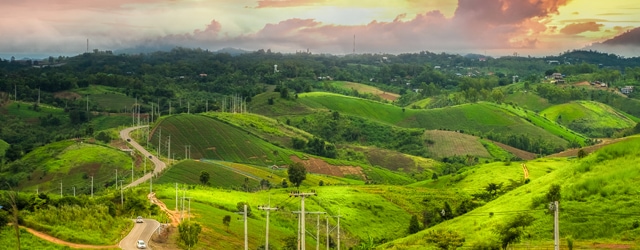Despite political conflict and an oil-crash hangover, policy-makers are forging ahead with reforms, and exports are boosting economic diversity.

Last year, after a difficult 2015, it seemed that just about everything that could go wrong for the South Caucasus actually did. In April, simmering tensions between Azerbaijan and Armenia over the contested region of Armenian-occupied Nagorno-Karabakh exploded into renewed and deadly conflict. Interventions by Russia and the Organization for Security and Cooperation in Europe (OSCE) calmed the situation somewhat, resulting in a ceasefire agreement. But exchanges of fire remain common.
Low energy prices continued to impact Azerbaijan’s economy, tamping down GDP by an estimated 3.5% and non-oil GDP by around 6%, and pushing the government—the main driver of investment—to cancel many projects. This worsened an outlook already clouded by devaluations of the national currency, the manat, and rising nonperforming loan ratios within the banking system (currently around 14%). By some calculations, per capita GDP has halved since the heyday of high oil prices in 2013.

The economies of the three South Caucasian countries—Armenia, Azerbaijan and Georgia—still suffer from Russia’s woes, especially Armenia, which is heavily dependent on Russia: remittances, mostly from Armenians working in Russia, are 20% of GDP, according to the CIA World Factbook. Worsening tensions in Turkey, a key trading partner, have injected further uncertainty. Meanwhile, the EU’s continuing problems and the election of Donald Trump in the US cast a pall. Tbilisi worries that the EU’s woes will distract Brussels from agreeing to visa-free travel, one of the final planks in the Association Agreement, and that the election of President Trump will undermine its longstanding close relationship with Washington DC.
“The South Caucasus faces more security challenges now than it did this time last year, with all three countries facing perceived or real enemies,” says Amanda Paul, South Caucasus specialist at the Brussels-based European Policy Centre think tank. “Deeply challenging economic circumstances will continue to complicate reform efforts.”
However, at a closer look, 2017 could turn out better than feared—assuming that there is no further deterioration in the geopolitical situation in the region. In Georgia, the Georgian Dream political party, which increased its majority at last October’s elections, has said it will press ahead with reforms—confident that pending agreements with the EU will give the country valuable market access. Sectors expected to directly benefit include agriculture, agribusiness, telecoms and tourism, with the latter being especially targeted for investment by hotels and airline groups. Observers are hopeful that the country will be able to secure GDP growth of around 4.5% this year, close to what it needs to start convergence with the EU.
“This government is more energetic and business focused. It knows what needs to be done and seems confident of doing it,” says Agris Preimanis, lead economist for Georgia at the European Bank for Reconstruction and Development (EBRD). “As a first step, it has sought to improve the business environment—already considered one of the most transparent in the emerging world.”
Inspired by Estonia’s example, it is also proceeding with new rules that abolish taxation on reinvested corporate profits. Georgia hopes the move will boost growth and investment, although it will obviously hit revenues initially. Georgia continues to attract large-scale FDI—at 9.8% of GDP, FDI almost covers Georgia’s current account deficit, which last year was 11.9%. And 2017 will see some large-scale projects commence, including a big gas pipeline from Azerbaijan that will boost employment and reduce energy costs. Bank nonperforming loans (NPLs) are now down around 4%, enabling banks to play an increasingly active role within the economy.
The big challenge for policymakers in Azerbaijan has been low energy prices, a blow for a country where energy accounts for 35% of GDP and 90% of export

earnings. The fiscal deficit last year hit 10%. However, EBRD’s economist for Azerbaijan and Armenia, Konstantine Kintsurashvili, says the $38 billion of reserves (equal to 100% of GDP) held in Sofaz, the state oil fund, and in the Central Bank of Azerbaijan shows underlying stability. The partial recovery in energy prices has also steadied nerves. “The sovereign liquidity position is strong: Azerbaijan’s foreign exchange reserves provide up to 30 months of import coverage,” Kintsurashvili says.
Baku has been pressing ahead with reforms aimed at improving the non-oil investment climate, increasing transparency and improving the licensing system for businesses. A new stand-alone supervision and regulatory body has been established for banks, which are expected to see serious consolidation over the next few years, with underperforming institutions closed or merged with stronger rivals. Still, the going will be tough. “Banks have been struggling to make repayments and have seen NPLs double,” says Paul Gamble, head of emerging Europe, sovereign ratings group at Fitch Ratings. “Against a background of weak growth, they aren’t well placed to provide credit or support the broader economy.” Gamble believes government plans to recapitalize, reorganize and privatize the International Bank of Azerbaijan, which accounts for more than one-third of bank sector assets, is proof that Baku is serious about reform. Analysts admit, though, that the government’s fiscal situation will recover—and with it, overall consumer and investor confidence—probably only when the planned phase-2 expansion of the Shah Deniz natural-gas field comes fully on-stream within the next few years.
Armenia’s ongoing shift from a presidential system toward a parliamentary one should ensure success for the dominant governing Republican Party of Armenia when voters go to the polls on April 2. Despite discontent with low living standards and with Armenia’s perceived losses in Nagorno-Karabakh last year (when Azerbaijan reclaimed a slice of the disputed territory), the party can claim some concrete successes: higher copper exports, the expected opening of production at the Amulsar gold mine early next year and improved relations with the EU. These are all positives, though the latter falls short of the Association Agreement Georgia negotiated with Brussels—not an option for Yerevan because of Armenia’s close ties to Russia.
|
Fitch Ratings: |
|
Azerbaijan = BB+ |
|
Armenia = B+ |
|
Georgia = BB- |
“Exports have been better than expected—particularly to the Middle East, which has emerged as an increasingly important partner—reflecting successful economic diversification, while the IMF program underpins and gives credibility to the reform program,” says Erich Arispe, director in Fitch Ratings’ sovereign team.
So what does the longer term hold for the South Caucasus? Most expect greater investment and interest from China. However, observers say that to draw investors these governments must bolster investment in infrastructure—notably roads and railroads.
“The key priority must be to boost interconnectivity, both regionally and globally,” argues Preimanis. “These countries all have potential, but they need to work much better together.”
|
Caucasus: At A Glance | |||
|
GDP Growth, % |
2016 |
2017 |
2011-2016 avg. |
|
Azerbaijan |
-3.5 |
2.5 |
1.8 |
|
Armenia |
0.8 |
2.1 |
4.3 |
|
Georgia |
2.5 |
4.2 |
4.1 |
|
Source: Fitch Ratings | |||
|
GNI per capita PPP-adjusted |
GDP per capita | ||
|
Azerbaijan |
$16,910 |
$3,882 | |
|
Armenia |
$8,550 |
$3,522 | |
|
Georgia |
$7,510 |
$3,606 | |
|
Source: Fitch Ratings | |||
|
FDI |
Stock |
Inflows |
FDI |
|
Armenia |
5.83 |
383 |
16.8 |
|
Georgia |
12.24 |
1.28bn |
35.3 |
|
Azerbaijan |
18.18 |
4.43bn |
25.1 |
Source: UNCTAD



